Collaboration of antibody and inflammation in clearance of rabies virus from the central nervous system
- PMID: 9557653
- PMCID: PMC109593
- DOI: 10.1128/JVI.72.5.3711-3719.1998
Collaboration of antibody and inflammation in clearance of rabies virus from the central nervous system
Abstract
To investigate the involvement of various cellular and humoral aspects of immunity in the clearance of rabies virus from the central nervous system, (CNS), we studied the development of clinical signs and virus clearance from the CNS in knockout mice lacking either B and T cells, CD8+ cytotoxic T cells, B cells, alpha/beta interferon (IFN-alpha/beta) receptors, IFN-gamma receptors, or complement components C3 and C4. Following intranasal infection with the attenuated rabies virus CVS-F3, normal adult mice of different genetic backgrounds developed a transient disease characterized by loss of body weight and appetite depression which peaked at 13 days postinfection (p.i.). While these animals had completely recovered by day 21 p.i., mice lacking either B and T cells or B cells alone developed a progressive disease and succumbed to infection. Mice lacking either CD8+ T cells, IFN receptors, or complement components C3 and C4 showed no significant differences in the development of clinical signs by comparison with intact counterparts having the same genetic background. However, while infectious virus and viral RNA could be detected in normal control mice only until day 8 p.i., in all of the gene knockout mice studied except those lacking C3 and C4, virus infection persisted through day 21 p.i. Analysis of rabies virus-specific antibody production together with histological assessment of brain inflammation in infected animals revealed that clearance of CVS-F3 by 21 days p.i. correlated with both a strong inflammatory response in the CNS early in the infection (day 8 p.i.), and the rapid (day 10 p.i.) production of significant levels of virus-neutralizing antibody (VNA). These studies confirm that rabies VNA is an absolute requirement for clearance of an established rabies virus infection. However, for the latter to occur in a timely fashion, collaboration between VNA and inflammatory mechanisms is necessary.
Figures
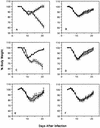
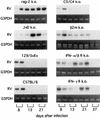
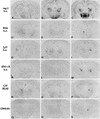
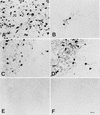
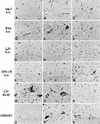
Similar articles
-
T-bet Is Required for the Rapid Clearance of Attenuated Rabies Virus from Central Nervous System Tissue.J Immunol. 2015 Nov 1;195(9):4358-68. doi: 10.4049/jimmunol.1501274. Epub 2015 Sep 25. J Immunol. 2015. PMID: 26408670 Free PMC article.
-
Revisiting rabies virus neutralizing antibodies through infecting BALB/c mice with live rabies virus.Virus Res. 2018 Mar 15;248:39-43. doi: 10.1016/j.virusres.2018.02.012. Epub 2018 Feb 19. Virus Res. 2018. PMID: 29471052
-
The production of antibody by invading B cells is required for the clearance of rabies virus from the central nervous system.PLoS Negl Trop Dis. 2009 Oct 6;3(10):e535. doi: 10.1371/journal.pntd.0000535. PLoS Negl Trop Dis. 2009. PMID: 19806203 Free PMC article.
-
Innate Immune Signaling and Role of Glial Cells in Herpes Simplex Virus- and Rabies Virus-Induced Encephalitis.Viruses. 2021 Nov 25;13(12):2364. doi: 10.3390/v13122364. Viruses. 2021. PMID: 34960633 Free PMC article. Review.
-
Rabies virus clearance from the central nervous system.Adv Virus Res. 2011;79:55-71. doi: 10.1016/B978-0-12-387040-7.00004-4. Adv Virus Res. 2011. PMID: 21601042 Review.
Cited by
-
Postexposure treatment with the live-attenuated rabies virus (RV) vaccine TriGAS triggers the clearance of wild-type RV from the Central Nervous System (CNS) through the rapid induction of genes relevant to adaptive immunity in CNS tissues.J Virol. 2012 Mar;86(6):3200-10. doi: 10.1128/JVI.06699-11. Epub 2012 Jan 11. J Virol. 2012. PMID: 22238315 Free PMC article.
-
Intravenous inoculation of a bat-associated rabies virus causes lethal encephalopathy in mice through invasion of the brain via neurosecretory hypothalamic fibers.PLoS Pathog. 2009 Jun;5(6):e1000485. doi: 10.1371/journal.ppat.1000485. Epub 2009 Jun 19. PLoS Pathog. 2009. PMID: 19543379 Free PMC article.
-
Safety of purified chick embryo cell rabies vaccine (Vaxirab N) after pre-exposure prophylaxis against rabies in children: is only adverse event profile enough?Hum Vaccin Immunother. 2014;10(2):317-8. doi: 10.4161/hv.26716. Epub 2013 Oct 8. Hum Vaccin Immunother. 2014. PMID: 24113798 Free PMC article. No abstract available.
-
Enhancement of blood-brain barrier permeability and reduction of tight junction protein expression are modulated by chemokines/cytokines induced by rabies virus infection.J Virol. 2014 May;88(9):4698-710. doi: 10.1128/JVI.03149-13. Epub 2014 Feb 12. J Virol. 2014. PMID: 24522913 Free PMC article.
-
MALT1 Controls Attenuated Rabies Virus by Inducing Early Inflammation and T Cell Activation in the Brain.J Virol. 2018 Mar 28;92(8):e02029-17. doi: 10.1128/JVI.02029-17. Print 2018 Apr 15. J Virol. 2018. PMID: 29367251 Free PMC article.
References
-
- Davis D R, Metzger H. Structural basis of antibody function. Annu Rev Immunol. 1983;1:87–117. - PubMed
-
- Dietzschold B, Schwaeble W, Schaeffer M K-H, Hooper D C, Zheng Y M, Petry F, Sheng H, Fink T, Loos M, Koprowski H, Weihe E. Expression of C1q, a subcomponent of the rat complement system, is dramatically enhanced in brains of rats with either Borna disease or experimental allergic encephalomyelitis. J Neurol Sci. 1995;130:11–16. - PubMed
Publication types
MeSH terms
Substances
Grants and funding
LinkOut - more resources
Full Text Sources
Medical
Research Materials
Miscellaneous

